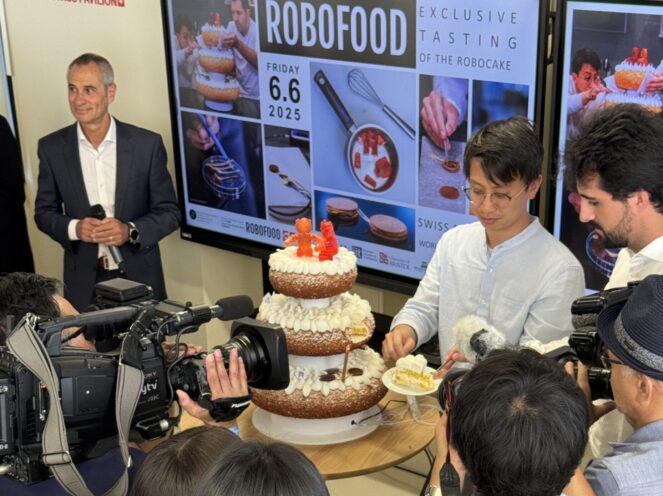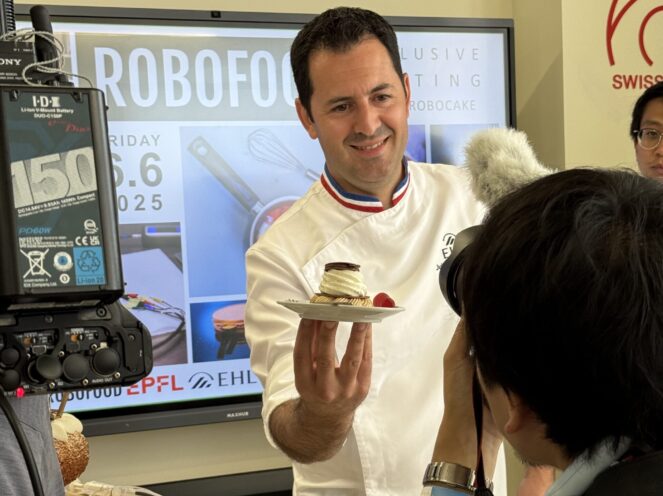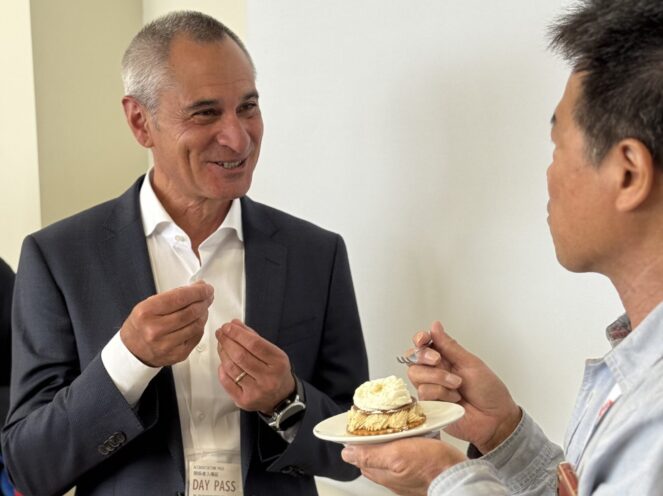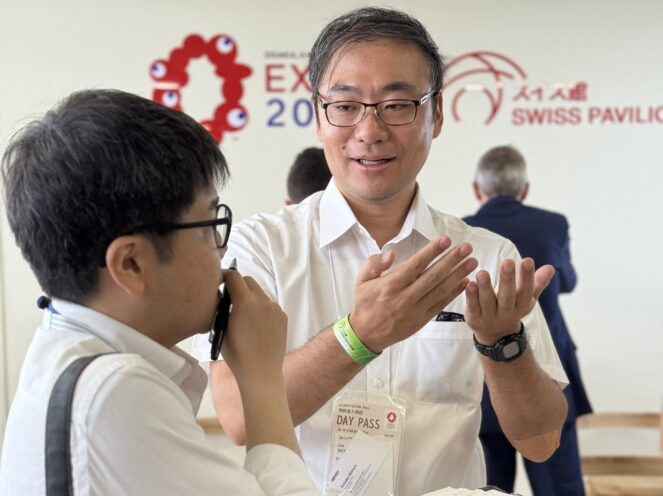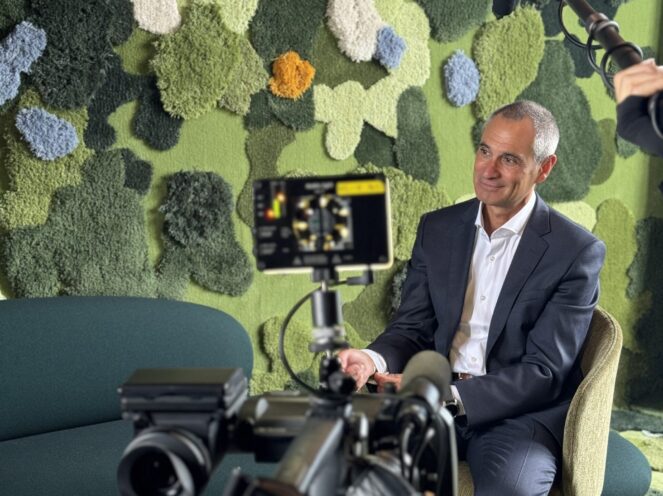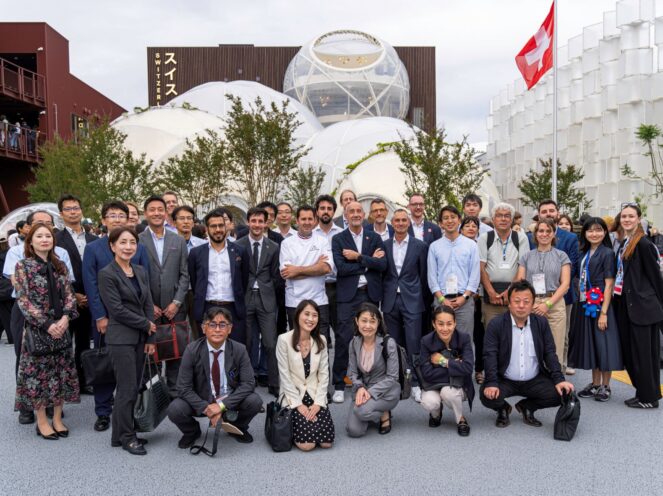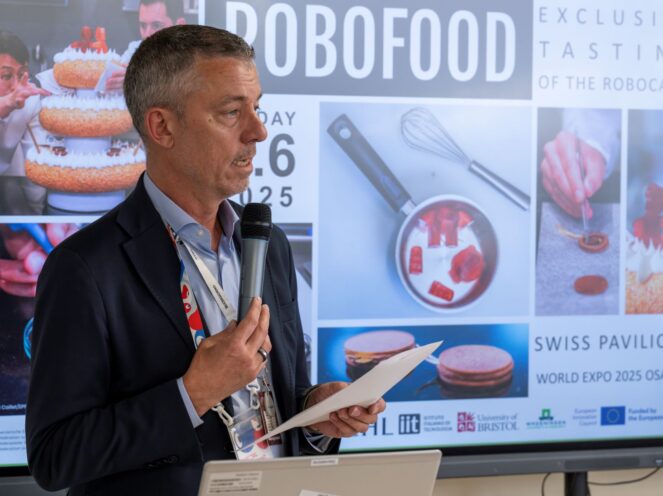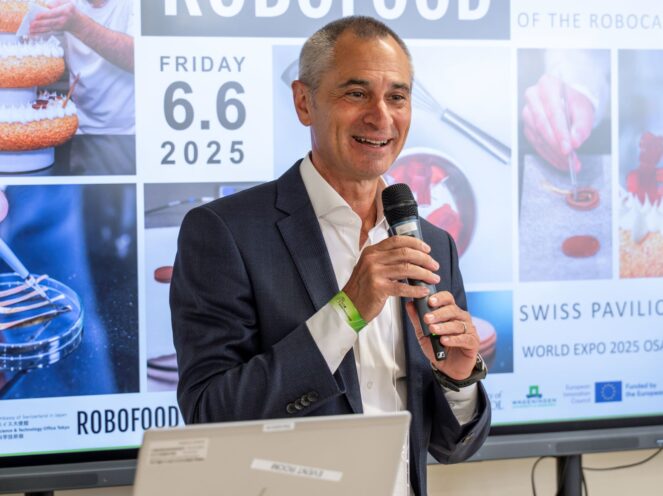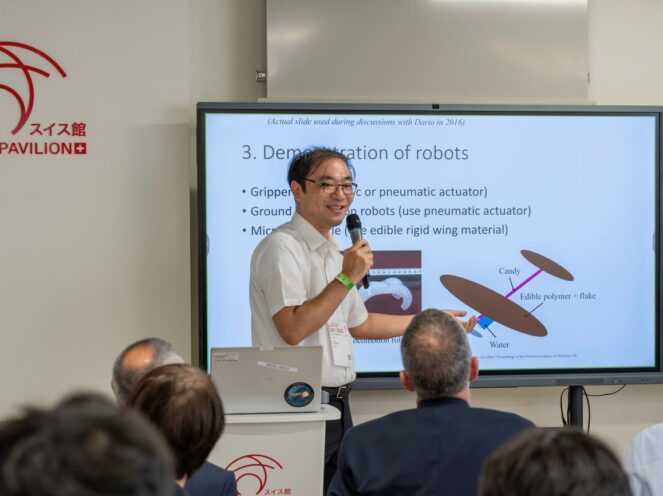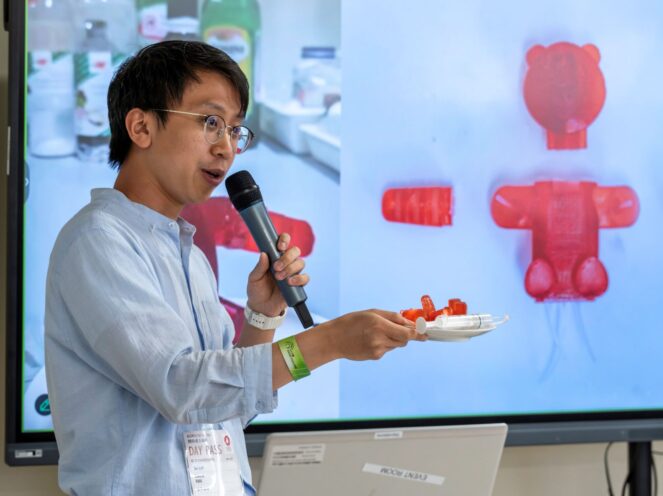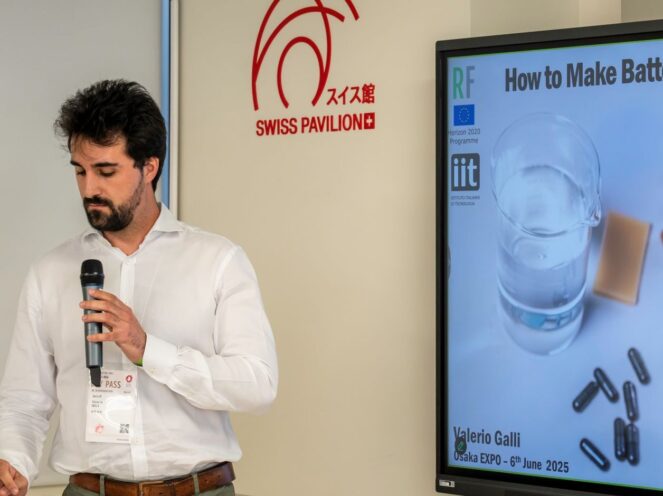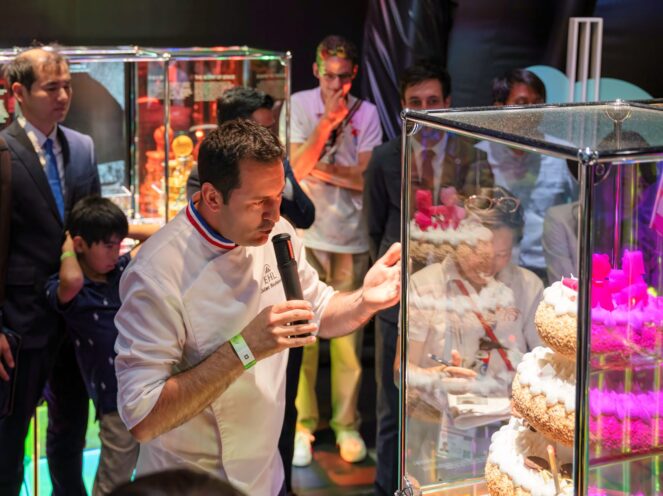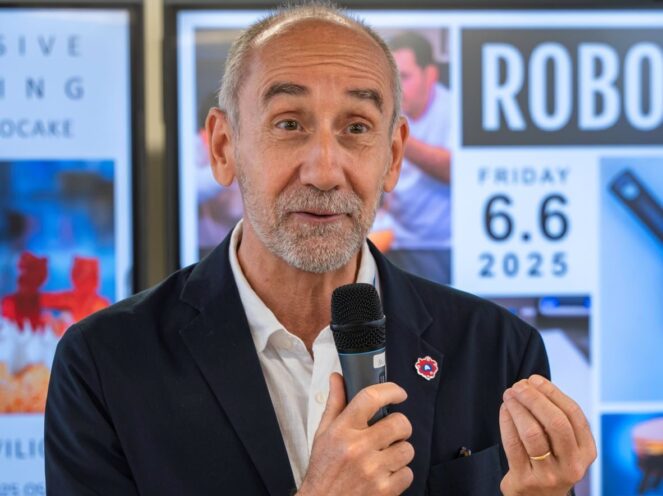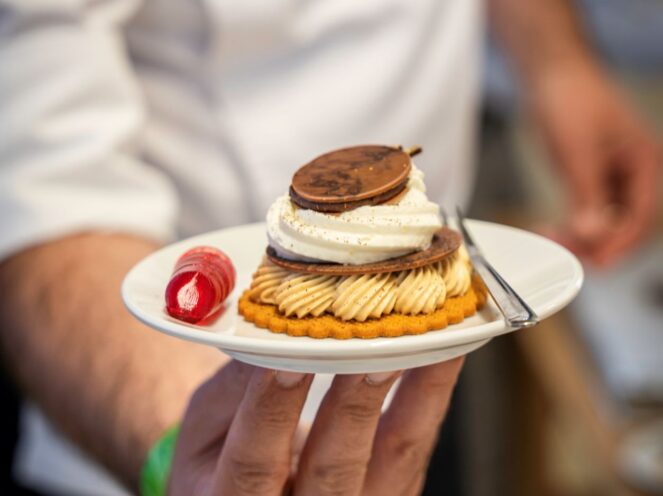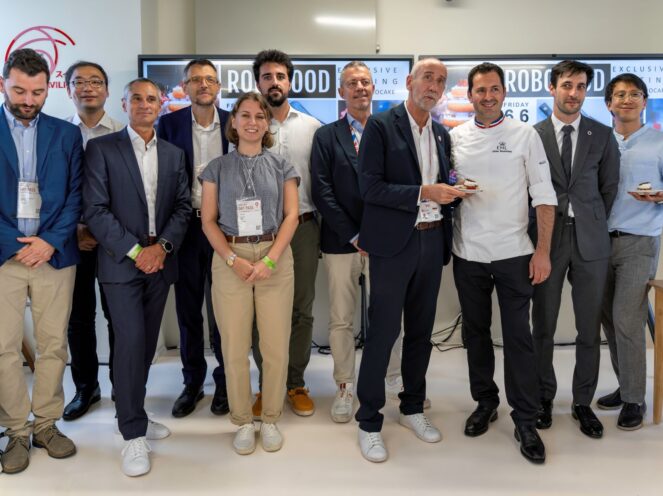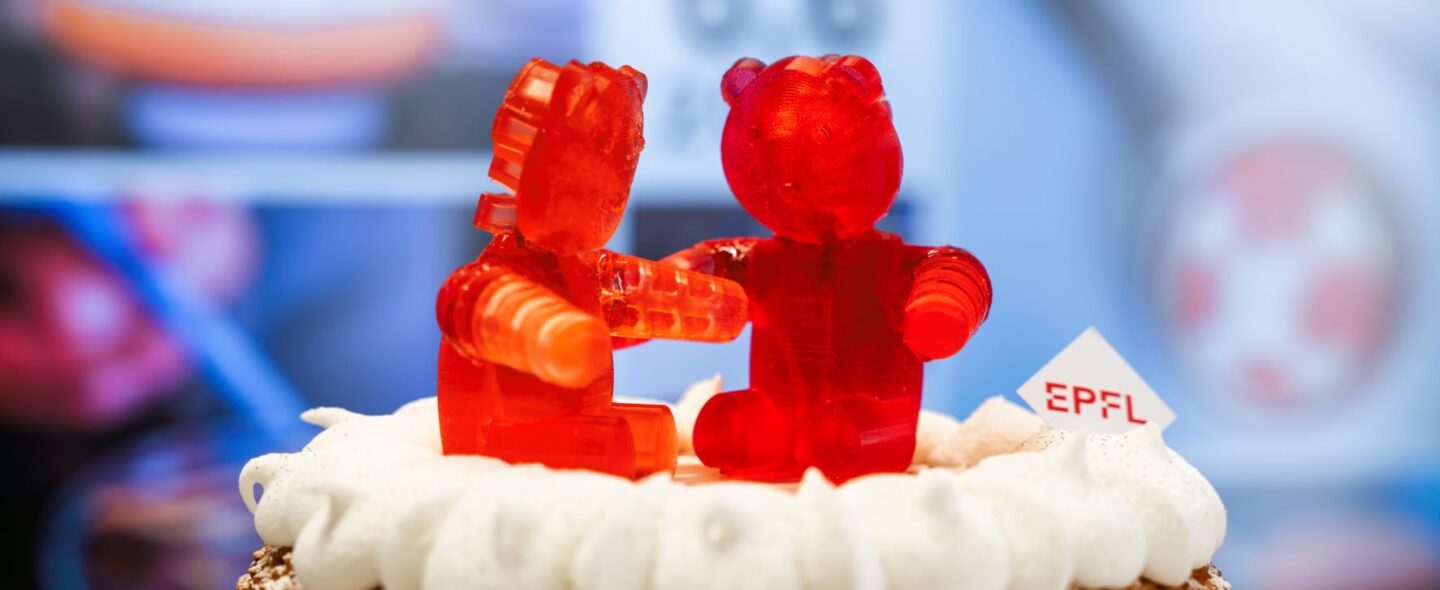
The groundbreaking event, introduced by the RoboFood project, in collaboration with the Science & Technology Office Tokyo, Embassy of Switzerland in Japan marked a milestone in the field of edible robotics. Developed through an interdisciplinary European partnership involving EPFL, the Istituto Italiano di Tecnologia (IIT), and the EHL Hospitality Business School, the RoboCake offered guests a glimpse into a future where food and machines merge.
The RoboFood day unfolded in three main segments: a press preview, an academic workshop, and an exclusive cake tasting.
Press Preview
Fueled by the interest of the media, the day began with an exclusive press preview that offered journalists a look into the behind-the-scenes of the RoboCake and the broader RoboFood initiative.
The presentations started with the RoboFood director Professor, Dario Floreano of EPFL. He explained the wide range of potential applications of edible robotics such as emergency nutrition, assistive care, sustainable aquaculture, animal and pet feed and even interactive dining experiences.
He was joined by Assistant Professor Jun Shintake, from the University of Electro-Communications who first conceived the concept of edible robotics during his doctoral studies at EPFL and Professor Mario Caironi from IIT, who shared the journey of taking the research from the laboratory to the kitchen, particularly the challenge of identifying edible materials for functional batteries.
Attendees were then invited to observe the RoboCake up close, with its gummy bears animated by pneumatic actuators moving gently, and twinkling LED candles powered by edible batteries, demonstrating that robotic elements could be fully integrated into edible formats without compromising food safety or appeal. A ceremonial cutting of the RoboCake by decorated pastry chef Julien Boutonnet, from EHL Hospitality Business School followed. Journalists captured the moment and their reactions on camera while sampling the innovative edible robotic dessert. The preview concluded with interviews and informal conversations with the research team who offered deeper insights into the science, engineering, and culinary craft behind RoboFood.
Link to Television OSAKA NEWS (in Japanese): https://www.youtube.com/watch?v=MEDGVi9UTdA
Academic Workshop
In the early afternoon, the event transitioned into a technical and purely research-focused academic workshop. This session brought together scientists from the RoboFood consortium namely EPFL, IIT, and the University of Bristol, and Japanese professors and students from leading universities in STEM across Japan specifically including Ritsumeikan University, the University of Electro-Communications, and the Shibaura Institute of Technology. The gathering created a dynamic forum for cross-cultural and interdisciplinary knowledge exchange between European and Japanese academic communities.
Participants took turns presenting their respective research, covering topics such as edible robotics, soft electronics, food-safe materials, and sustainable food-robot integration. Demonstrations of working prototypes and samples accompanied some of the talks, giving attendees a tangible sense of cutting-edge research.
The workshop encouraged thought-provoking discussion across both disciplinary and cultural lines. It offered participants a chance to share perspectives, compare methodologies, and explore new directions for collaboration, in line with the belief that innovation benefits from diverse inputs and open exchange.
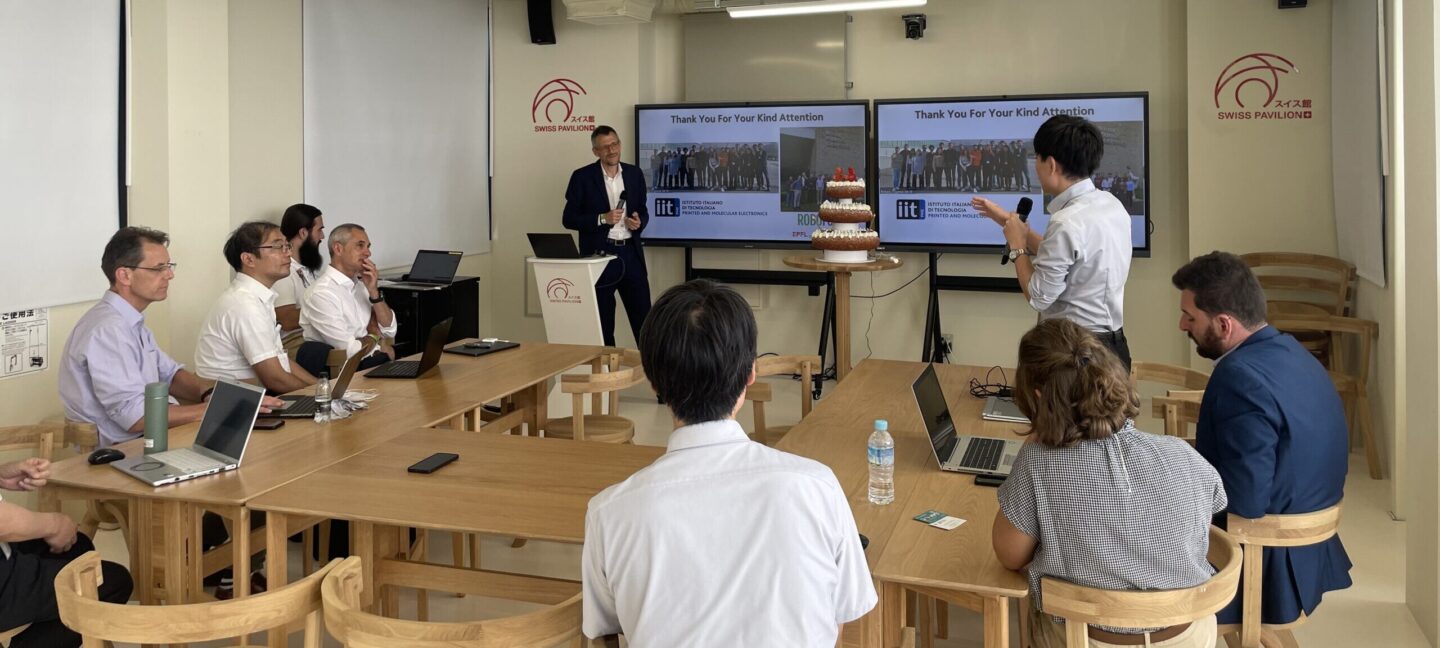
Exclusive Cake Tasting
The day culminated in the much-anticipated RoboCake tasting event. Mr. Manuel Salchli, Commissioner General Swiss Pavilion Expo 2025 Osaka, welcomed the guests to the Swiss Pavilion with warm opening remarks. He highlighted the visionary scope of the RoboFood project and emphasized Switzerland and Japan’s shared values of innovation, excellence, and respect for traditions.
Taking the stage, project director Professor Dario Floreano opened with an introduction to RoboFood’s vision toward a future where robots can be eaten, and food can function like robots in front of distinguished guests including President & CEO of Lindt & Sprüngli Japan, Ms. Chiaki Fukumoto and Vice President of the Japan Science and Technology Agency (JST), Mr. Akira Tsugita.
Nowadays, robots can be used for food harvesting, cooking, packaging, serving, delivering, or even feeding people who need assistance. RoboFood goes one step further by thinking of different applications for edible robots such as enabling precise drug delivery and in vivo health monitoring, delivering nutrition in emergency situations, reducing waste in farming, and producing novel gastronomical experiences. His presentation highlighted key technological breakthroughs, including understanding the mechanical properties of edible robot components, soft actuators, edible sensors, and biodegradable power sources.
Assistant Professor Jun Shintake followed with a brief personal reflection on the origins of the RoboFood concept. He recalled how, one night in 2016, he found himself stranded at a train station in Switzerland. His hunger prompted an unexpected spark of inspiration: he thought about making robots edible and proposed the idea to his then PhD supervisor, Prof. Dario Floreano, marking the start of their research in edible robots and the formulation of RoboFood. “Being hungry fueled a hungry spirit,” he said.
Key researchers of the RoboCake project then shared insights from the lab. Dr. Bokeon Kwak demonstrated the engineering process behind the pneumatic gummy bear robots, designed to move when the pneumatic system is activated. Valerio Galli introduced the dark chocolate-based edible batteries that powered the LED candles on the RoboCake, highlighting the challenge of designing power sources that are not only functional but also safe to consume.
Guests were then invited to a brief guided tour of the Swiss Pavilion to view the RoboCake installation up close with further explanations from chef Julien Boutonnet and Mr. Antonin Soussan of EHL. The three-layered creation represented each of the core partners: EPFL, IIT, and EHL. The top layer featured animated gummy bears developed by EPFL, the base included IIT’s edible power systems, and the central layer highlighted EHL’s contribution to culinary design and taste.
Upon returning to the main event space, the EU Ambassador to Japan, H.E. Jean-Eric Paquet, offered a celebratory toast honoring international collaboration and the spirit of innovation.
Finally, the moment everyone had been waiting for arrived: the RoboCake was served. As guests sampled the edible and sophisticated robotic dessert, reactions ranged from surprise to delight. The RoboFood is a powerful symbol of what is possible when science, creativity, and interdisciplinary and international collaboration come together, offering not just food for thought, but delicious food that moves, and lights up!
-
![]()
-
![]()
Mr. Manuel Salchli
Swiss Pavilion Expo 2025 Osaka
-
![]()
Prof. Dario Floreano
EPFL
-
![]()
Prof. Jun Shintake
University of Electro-Communications
-
![]()
Dr. Bokeon Kwak
EPFL
-
![]()
Mr. Valerio Galli
Istituto Italiano di Tecnologia (IIT)
-
![]()
Chef Julien Boutonnet
EHL Hospitality Business School
-
![]()
H.E. Jean-Eric Paquet
The Delegation of the European Union to Japan
-
![]()
-
![]()
H.E. Jean-Eric Paquet with Mr. Manuel Salchli, and the RoboCake team
From left to right: Valerio Francesco Annese, Jun Shintake, Dario Floreano, Mario Caironi, Giulia Coco, Valerio Galli, Manuel Salchli, H.E. Jean Eric Paquet, Julien Boutonnet, Antonin Soussan, and Bokeon Kwak
